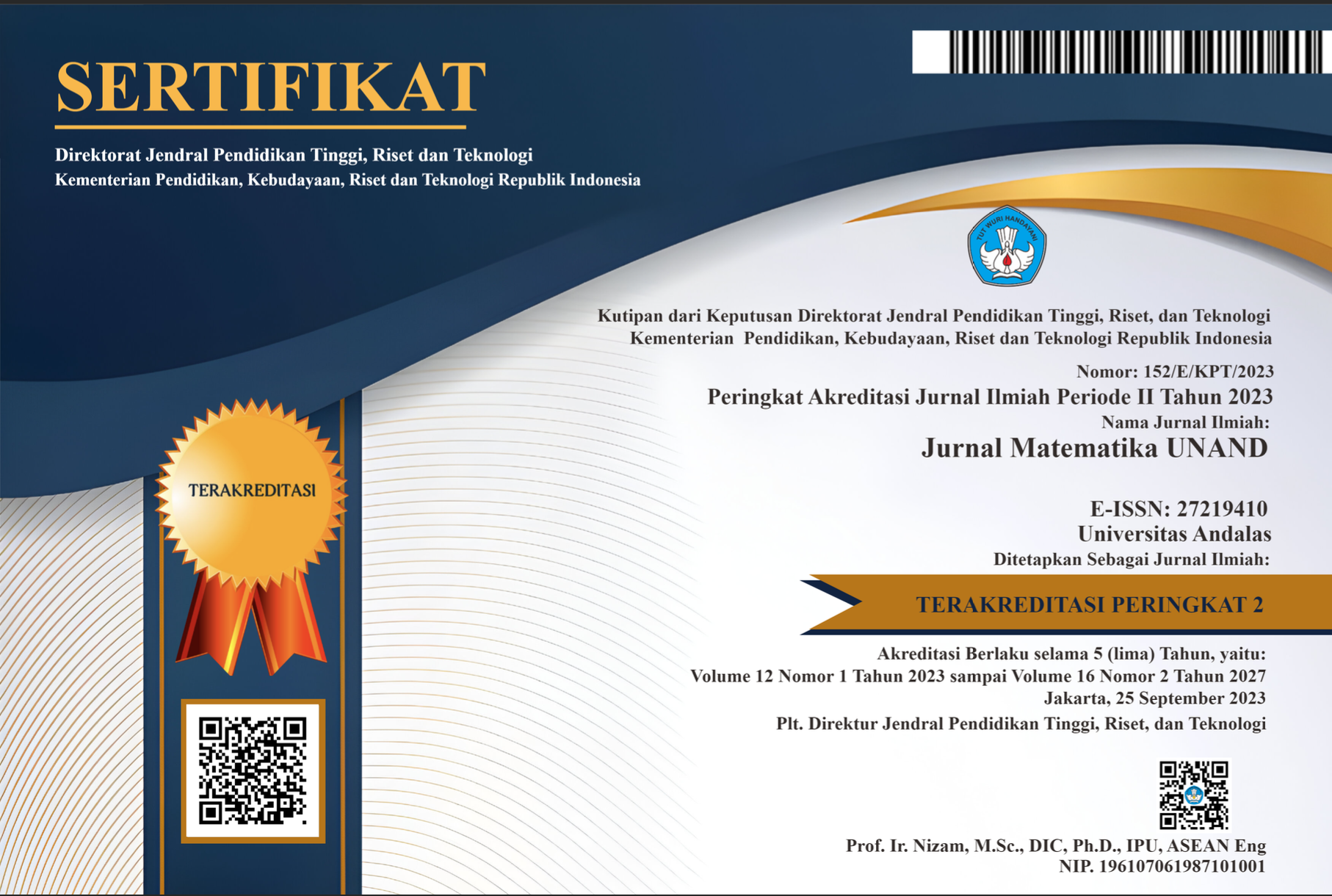OPTIMASI SISTEM PERENCANAAN PERSEDIAAN BUAH MENGGUNAKAN MODEL PROBABILISTIC FUZZY INVENTORY MULTI-ITEM DENGAN FUZZY LEAD-TIME
Abstract
Abstrak: Perencanaan kebijakan persediaan sangat penting terutama untuk produk-produk yang mudah rusak. Buah-buahan adalah jenis produk yang tidak tahan lama jika tidak disimpan di dalam pendingin.Tingkat kerusakan buah akan semakin meningkat jika disimpan lebih lama tanpa menggunakan ruang khusus. Hal ini berakibat menurunnya pada permintaan buah sehingga diasumsikan tingkat permintaan mengikuti distribusi eksponensial negatif. Waktu pengiriman buah ke pedagang juga tidak diketahui dengan pasti, maka nilai parameter leadtime dinyatakan dengan bilangan fuzzy. Pada makalah ini dibahas pemasalahan optimasi persediaan buah untuk meminimumkan total biaya persediaan. Terdapat 2 jenis buah yang dipertimbangkan yaitu jeruk dan salak. Model persediaan probabilistic fuzzy multi item dapat digunakan untuk menyelesaikan masalah persediaan. Berdasarkan parameter yang ditentukan diperoleh waktu peninjauan awal buah jeruk adalah 1,75 hari dan buah salak adalah 2,83 hari. Total biaya persediaan dengan variasi nilai beta semakin kecil untuk nilai beta semakin mendekati satu.
Kata kunci: Fuzzy, , Inventori multi item, Probabilistik
Full Text:
PDFReferences
X. Zheng, M. Yin, and Y. Zhang, “Integrated Optimization of Location , Inventory and Routing In Supply Chain Network Design,” Transp. Res. Part B, vol. 121, pp. 1–20, 2019.
S. Sanni and B. O. Neill, “Computers & Industrial Engineering Inventory optimisation in a three-parameter Weibull model under a prepayment system,” Comput. Ind. Eng., vol. 128, no. December 2018, pp. 298–304, 2019.
L. E. Cárdenas-barrón, A. A. Shaikh, S. Tiwari, and G. Treviño-garza, “An EOQ inventory model with nonlinear stock dependent holding cost, nonlinear stock dependent demand and trade credit,” Comput. Ind. Eng., 2018.
X. Luo and C. Chou, “International Journal of Production Economics Technical note : Solving inventory models by algebraic method,” Int. J. Prod. Econ., vol. 200, no. March, pp. 130–133, 2018.
J. Rezaeian, S. Haghayegh, and I. Mahdavi, “Designing an Integrated Production / Distribution and Inventory Planning Model of Fixed-life Perishable Products,” J. Otimization Ind. Eng., vol. 19, pp. 47–59, 2016.
N. R. Dewi, E. Susanti, E. Roflin, T. B. Octalia, and R. Novita, “Optimization production and distribution using production routing problem with perishable inventory (PRPPI) models,” J. Phys. Conf. Ser., vol. 1282, no. 1, pp. 0–10, 2019.
Z. Azadi, S. D. Eksioglu, B. Eksioglu, and G. Palak, “Stochastic Optimization Models for Joint Pricing and Inventory Replenishment of Perishable Products,” Comput. Ind. Eng., vol. 127, no. January, pp. 625–642, 2019.
S. J. Sadjadi, A. Makui, E. Dehghani, and M. Pourmohammad, “Applying queuing approach for a stochastic location-inventory problem with two different mean inventory considerations,” Appl. Math. Model., vol. 40, no. 1, 1 January 2016578-596, pp. 578–596, 2016.
N. R. Dewi, B. Suprihatin, A. Bidarti, S. Elpatrika, and N. A. A. Masyitha, “Implementasi Model Stokastik Pada Permasalahan Optimasi Persediaan Kelapa Pada Tingkat Distributor,” E-Jurnal Mat., vol. 9, no. 1, p. 90, 2020.
T. Garai, D. Chakraborty, and T. K. Roy, “Fully fuzzy inventory model with price-dependent demand and time varying holding cost under fuzzy decision variables,” J. Intell. Fuzzy Syst., vol. 36, no. 4, pp. 3725–3738, 2019.
S. S. Routray, S. K. Paikray, S. Mishra, and U. K. Misra, “Fuzzy Inventory Model With Single Item Under Time Dependent Demand and Holding Cost,” no. July, pp. 1604–1618, 2020.
S. Rani, R. Ali, and A. Agarwal, Fuzzy Inventory Model for Deteriorating Items in a Green Supply Chain with Carbon Concerned Demand, vol. 56, no. 1. Springer India, 2019.
S. E. N. Nabendu and S. Saha, “Inventory model for deteriorating items with negative exponential demand, probabilistic deterioration, and fuzzy lead time under partial back logging,” Oper. Res. Decis., vol. 30, no. 3, pp. 97–112, 2021.
D. Lesmono and T. Limansyah, “A multi item probabilistic inventory model,” J. Phys. Conf. Ser., vol. 893, no. 1, 2017.
S. K. Das and S. Islam, “Fuzzy Multi item Inventory Model with Deterioration and Demand Dependent Production Cost under Space Constraint: Neutrosophic hesitant fuzzy programming approach,” Neutrosophic Sets Syst., vol. 28, no. 2019, pp. 281–294, 2019.
J. Jayanthi and M. Maragatham, “Multi Item Fuzzy Inventory Model for Imperf
DOI: https://doi.org/10.25077/jmua.12.1.86-94.2023
Refbacks
- There are currently no refbacks.
Copyright (c) 2023

This work is licensed under a Creative Commons Attribution-ShareAlike 4.0 International License.

Ciptaan disebarluaskan di bawah Lisensi Creative Commons Atribusi-BerbagiSerupa 4.0 Internasional.










